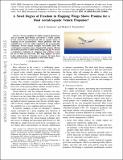A novel degree of freedom in flapping wings shows promise for a dual aerial/aquatic vehicle propulsor
Author(s)
Izraelevitz, Jacob Samuel; Triantafyllou, Michael S
DownloadA novel degree.pdf (1.571Mb)
OPEN_ACCESS_POLICY
Open Access Policy
Creative Commons Attribution-Noncommercial-Share Alike
Terms of use
Metadata
Show full item recordAbstract
Ocean sampling for highly temporal phenomena, such as harmful algal blooms, necessitates a vehicle capable of fast aerial travel interspersed with an aquatic means of acquiring in-situ measurements. Vehicle platforms with this capability have yet to be widely adopted by the oceanographic community. Several animal examples successfully make this aerial/aquatic transition using a flapping foil actuator, offering an existence proof for a viable vehicle design (Fig. 1).We discuss a preliminary realization of a flapping wing actuation system for use in both air and water. The wing employs an active in-line motion degree of freedom to generate the large force envelope necessary for propulsion in both fluid media.
Date issued
2015-07Department
Massachusetts Institute of Technology. Department of Mechanical EngineeringJournal
Proceedings of the 2015 IEEE International Conference on Robotics and Automation (ICRA)
Publisher
Institute of Electrical and Electronics Engineers (IEEE)
Citation
Izraelevitz, Jacob S., and Michael S. Triantafyllou. “A Novel Degree of Freedom in Flapping Wings Shows Promise for a Dual Aerial/Aquatic Vehicle Propulsor.” Proceedings of the 2015 IEEE International Conference on Robotics and Automation (ICRA), 26-30 May 2015, Seattle, WA, USA, IEEE, 2015: 5830–5837.
Version: Author's final manuscript
ISSN
1050-4729